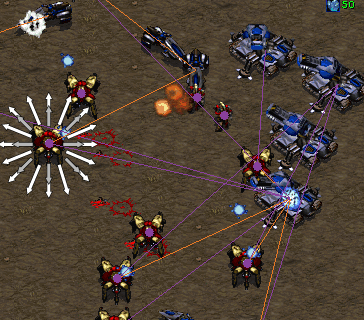Section: New Results
Bayesian Modelling of Sensorimotor Systems and Behaviors
Results proposed in this section were done in collaboration with the LPPA collège de France.
Bayesian programming applied to a multi-player video games
Participants : Gabriel Synnaeve, Pierre Bessière.
The problem addressed in this work is the autonomous replacement of a human player. It is the continuation of last year's work on the same topic as well as a follow-up of previous E-Motion Ph.D Ronan Le Hy [61] . This year, we focused on real-time strategy (RTS) games, in which the players have to build an economy, advance technology, produce and control an army to kill the opponents. From a research point of view, multi-player games are interesting because they stand for a good in-between of the real world and simulations. The world is finite and simulated (no sensors problems) but we didn't wrote the simulation and the other players are humans (or advanced robots in the case of AI competitions).
This year's research work focused on plan recognition from noisy and incomplete observations. Previous plan recognition works in multiplayer games were mainly based on planning and case-based reasoning (CBR) [92] , [68] , [55] , [76] or HMMs [41] . CBR allows for taking domain knowledge into account easily while not dealing efficiently with uncertainty/incompleteness of information, HMMs deal with uncertainty quite well but domain knowledge is harder to structure. We found different ways to decompose the joint which allows for tractable and robust inference. For instance with the help of intermediate variables which can be derived from domain knowledge (as we did) or found automatically (e.g. cross-validation on a HMM). Particularly, we were able to structure dependencies between domain knowledge extracted variables using coherence variables. We then learn the parameters of such joint distributions from data. Supervised (labeled), and semi-supervised learning (when we label automatically from clustering) have led to a publication at CIG (IEEE) 2011 [19] and unsupervised learning (using only raw game data) led to a publication at AIIDE (AAAI) 2011 [20] .
On top of the research/evaluation implementation, we also implemented it in our StarCraft: Broodwar's bot implementation BroodwarBotQ. With this bot, we took part in AIIDE and CIG conferences AI tournaments placing respectively 9th (out of 18) and 4th (out of 10). We also published last year's result on multiple units control in real-time engagements (see 23 ) at CIG (IEEE) 2011 [21] . As optimal micro-management is almost always intractable (P-space) in real situations, we considered each unit as a Bayesian sensory motor robot which makes a fusion of its sensory inputs about the world, the enemy units, but also its allies (without explicit communication for less complexity) and higher level directions. So the units only take short term decision on where to go and who to attack, higher level planning is done at a squad (and then army) level and given as a sensory input. Results in micro-management tournaments are state of the art. In the more general case, they could be improved by reinforcement learning of the models parameters.
We are now working on concurrent goals resources attribution, still in the context of incomplete knowledge about the opponent. We are also working on correlating low-level observations (effects) and high-level inferences (causes) about the enemy strategy to be able to predict its future behavior.
|
Bayesian modelling to implement and compare different theories of speech communication
Participants : Raphael Laurent, Pierre Bessière, Julien Diard, Jean-Luc Schwartz.
A central issue in speech science concerns the nature of representations and processes involved in communication. The search for phoneme or syllable specific invariants led to three major sets of approaches: motor, auditory and perceptuo-motor theories, which have been widely argued for and against. The debate appears to be stagnating. This work is based on the belief that mathematical modeling of these theories could provide breakthroughs. More precisely, it is proposed that casting these theories into a single, unified mathematical framework would be the most efficient way of comparing the theories and their properties in a systematic manner.
Bayesian modeling provides a mathematical framework that precisely allows such comparisons. The same tool, namely probabilities, can be used both for defining the models and for comparing them. Moreover, the use of a unified framework implies that common hypotheses would have common mathematical translations. This helps toward more principled studies of the competing theories.
Following this integrative approach, the motor, auditory and perceptuo-motor theories are thus cast into one unifying Bayesian framework in which they all appear as instances of various questions asked to one probabilistic communication model. This allows to compare these theories through quantitative testing in various paradigms. The work is aimed at understanding the differences in the predictions given by the different theories, and from these predictions to suggest experiments involving human subjects.
The model was used first to work on purely theoretical simulations aimed at studying with diverse paradigms the decrease in the performances predicted by the different theories due to communication noise. It was then used to work on plosive syllables production and perception, thanks to VLAM, a vocal tract simulation tool, which allows to map articulatory parameters to acoustic signals.



